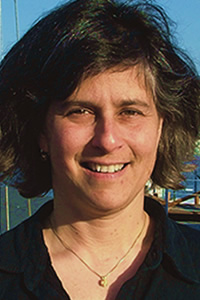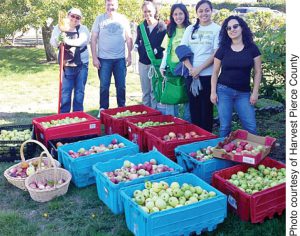
Sally Brown
BioCycle February 2016
They say that everything old is new again. While I’m still waiting for that to happen on a personal level, it is happening with the term “gleaning.” More recent definitions of gleaning refer to ways of gaining information or other things from multiple sources or over time. The historical definition also focuses on gathering but here what is gathered is edible. Food left in a field after harvest is gleaned. There is a painting by Jean-François Millet from 1857 called the Gleaners showing peasants gathering grain in a field after harvest.
Today, in many communities across the country, the same thing is going on and the picture is even lovelier. Gleaning is a way that extra food from fields and fruit from trees can be gathered and used to provide sustenance for those in the community in need. It is a way that people in a community can give back. It is a way that high quality, fresh foods can avoid becoming waste. This may sound like one of those niche ideas that has minimal potential for actual impact, but the data where gleaning is taking place suggest otherwise.
As has happened before in this “Connections” column, you’ll get the Tacoma, Washington version of the story. That is because I learned about gleaning from Kristen McIvor, the head of Harvest Pierce County, the Urban Agriculture wing of Pierce Conservation District in Pierce County, Washington. Tacoma’s gleaning program, started in 2009, is a multifaceted initiative that last year donated over 100,000 pounds of food to local food banks. That includes produce grown in community gardens and commercial farms and a farm where produce is grown specifically for food banks. It also includes fruit from neighborhood trees and excess from farmers markets.
The gleaning program employs 1.5 FTEs (full-time equivalents) and is supported in part by Pierce County and the Washington State Department of Ecology. This support is justified as a waste reduction strategy although it can clearly also be valued for the social benefits associated with the program. “Wow,” you say, I want a gleaning program in my community! First, you just might have one. And if not, here is the story of how the Tacoma program got started, so you glean some information, and start a program of your own.
Fruit Scouts

Fruit Scouts monitor urban fruit trees. When ripe, harvest leaders recruit volunteers, who carpool to the trees with equipment to do the picking. Harvested fruit is brought to food banks.
The gleaning initiative in Tacoma was started in 2009 by St. Leo’s, the largest food bank in Tacoma, in collaboration with Jesuit Volunteer NW. The next year, the Emergency Food Network (EFN) of Pierce County built on the idea and applied for a three year grant through Rotary First Harvest for an Americorps volunteer to build the program and take it to the next level. Harvest Pierce County (HPC) got involved initially as partners when the gleaning program worked together with HPC to give out plant starts to gardeners interested in growing to donate. In the third year of the Americorps grant, the program was transferred to HPC as a logical extension of its existing community gardens.
Several years in, here is how it works. Donations come from two main sources — farms and urban fruit trees. A database called Gleanweb was provided by Salem Harvest, a gleaning program in Salem, Oregon that is bigger and older than the program in Tacoma. For the urban fruit trees, the project started with outreach to identify suitable trees and willing tree owners. Volunteers called “Fruit Scouts” go look at potential trees, as well as dogs or fences. They also figure out about when the fruit will be ripe. HPC works as a dispatcher, calling the owner to say the fruit will be ready soon. Sometimes the owner calls them. Then it is time to assign a volunteer harvest leader.
Eight harvest leaders are assigned one tree each per week. They recruit volunteers via email to help the leader with the harvest. Volunteers carpool to the tree with equipment provided by the leader. Fruit is harvested and brought to a food bank (which one depends on where the harvest is taking place and what time of day it is). Some food banks make special arrangements to have a volunteer ready and available to accept donations as the fruit often arrives after business hours. These fruit trees in Tacoma provided 29,000 pounds of fruit to the food banks in 2015.
The gleaning program also works with farmers. This work involves collecting culls or produce not suitable for sale as well as produce that for various reasons does not make it to market. Volunteers are targeted to include those who will benefit directly from the food donations. These volunteers are given preference to help collect the harvest from commercial farms.
Finally, the gleaning program benefits from an initiative within the community gardens called Share the Harvest. Many, if not most, gardens have a bed that is set aside specifically for food banks.
The first few years of the gleaning program in Tacoma were focused on outreach — finding the farmers and finding the trees. At this point the focus is more on how to manage the whole thing. In many cases there are an excess of volunteers. The City of Tacoma started giving out fruit trees, so soon there may be an excess of those as well. The number of gardens in Tacoma and Pierce County has also been increasing, meaning more dedicated beds for donations. All of this provides high quality fresh foods for the food banks and helps move produce to where it will be turned into food instead of food waste.
I like this old definition of gleaning, especially that this old definition is becoming new again.
Sally Brown is a Research Associate Professor at the University of Washington in Seattle and a member of BioCycle’s Editorial Board.












